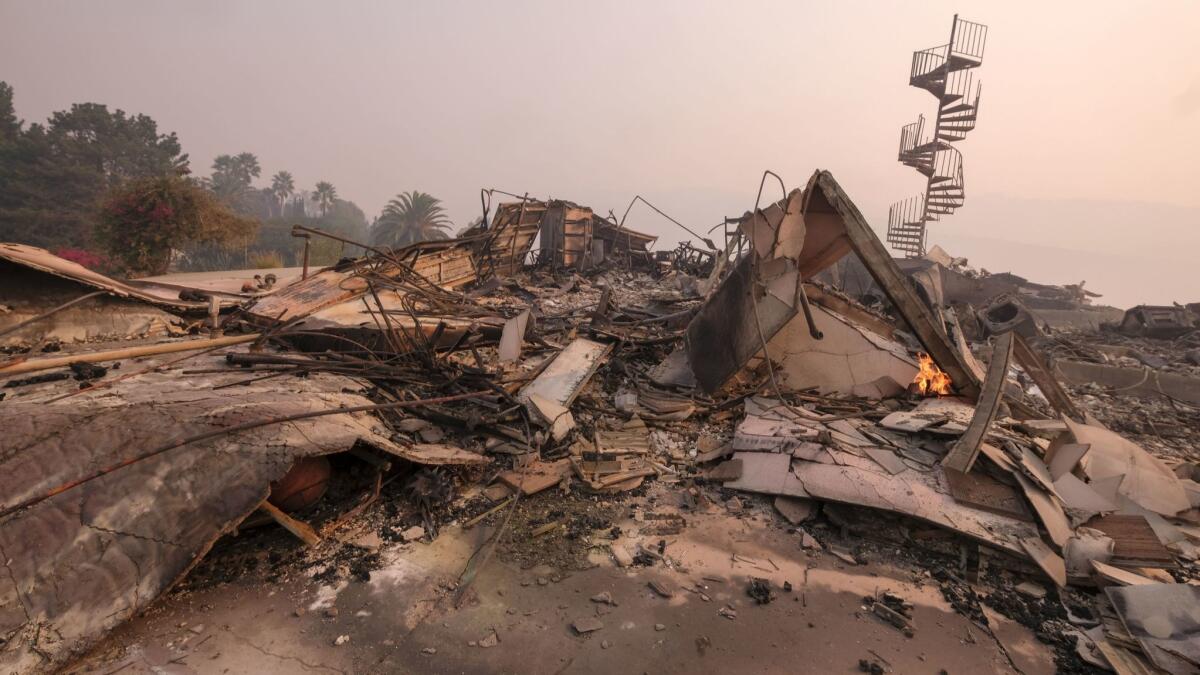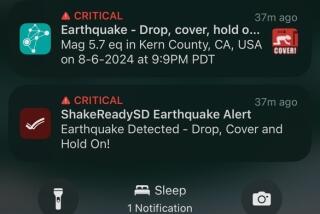Editorial: In the wake of deadly wildfires, California needs a reliable emergency alert system to save lives

When fast-moving fires swept through both suburban neighborhoods and rural enclaves in California wine country last year, many residents complained that they only learned of the late-night blaze from neighbors banging on their doors, barking dogs or calls from friends — not from official emergency alerts. With flames at their doorsteps, people had to grab what they could and flee. Some didn’t evacuate in time; 44 people died.
That terrifying scene has continued to play out, again and again.
During the Carr fire last summer in Redding and Shasta County, some residents didn’t receive evacuation orders in time, or at all. A grandmother and her two grandchildren died when fire engulfed their trailer. Their family said they never got word of the evacuation order and didn’t know they were in danger until it was too late.
And this month, many residents in Paradise said they didn’t get emergency alerts as the Camp fire closed in on the town. Others said they received official notifications only after it was already obvious that their lives were in danger. More than 60 people died in the fire and more than 600 people were still missing Friday.
Disasters have revealed that the state’s emergency warning systems, which are generally administered by cities and counties, are not working adequately.
In each case, local officials said the fires moved so fast and so unpredictably that their emergency alert systems couldn’t keep pace. And it is certainly true that California has been experiencing more ferocious, destructive, swiftly spreading fires in recent years — fueled by drought and warmer temperatures.
But the disasters have also revealed that the state’s emergency warning systems, which are generally administered by cities and counties, are not working adequately. Residents understandably assume they’ll receive notification well before they are in imminent danger, and with clear instructions on what to do, even if they haven’t signed up in advance for alerts.
And why wouldn’t they? We live in a hyper-connected world, and we’re used to being bombarded with robocalls and Amber Alerts. There is an expectation that local authorities will use that technology in emergencies to provide accurate, essential information.
However, a state audit report following the wine country fires found that Sonoma County’s emergency alert procedures were “uncoordinated and included gaps, overlaps and redundancies.”
Those problems are not unique to Santa Rosa, experts say. Local alert systems across the state are inconsistent, underfunded and ill-prepared for fast-moving emergencies. Many counties and cities in California have relied on reverse 911 systems that automatically dial landlines. But as more people use cellphones instead of landlines, that system becomes increasingly ineffective. Because of that, officials in some communities have relied on residents to voluntarily sign up for emergency phone calls. But sign-up levels are low.
Local authorities can tap the federal Wireless Emergency Alert system to send an Amber Alert-like message to any mobile phone within range of a working cell tower. But investigations following the recent deadly fires found that officials haven’t used the system much, relying instead on private vendors’ systems that don’t reach as many people. Some agencies, particularly in small counties with limited staff, were unfamiliar with how to use the federal system. Others feared a mass message that went out too broadly could cause a panic that makes evacuations more difficult. Those are legitimate issues.
Enter the Fray: First takes on the news of the minute from L.A. Times Opinion »
In response, the Federal Communication Commission adopted new rules earlier this year requiring wireless providers to deliver emergency alerts to more geographically precise areas by November 2019. That should encourage local authorities to use the alerts more frequently. A bill signed by Gov. Jerry Brown in September will set statewide standards for when and how to warn the public about wildfires, floods and other emergencies.
If California is going to protect its residents from the growing threat of wildfires, the state has to prepare for the unpredictable. Alerts alone won’t save lives. Even if every resident of Paradise had received the first official notification of the fire and had begun to evacuate, they still might have been overtaken by the incredibly fast-moving fire or possibly been trapped in traffic on the few roads out of town.
Yet compared to the other more expensive and more politically fraught work needed to make California more wildfire-resilient — such as requiring property owners to retrofit their homes with fire-safe materials, restricting development in high-fire areas and thinning and burning dense, overgrown forests — developing comprehensive, reliable emergency alert systems should be a relatively easy way to save lives.
Follow the Opinion section on Twitter @latimesopinion and Facebook
More to Read
A cure for the common opinion
Get thought-provoking perspectives with our weekly newsletter.
You may occasionally receive promotional content from the Los Angeles Times.










